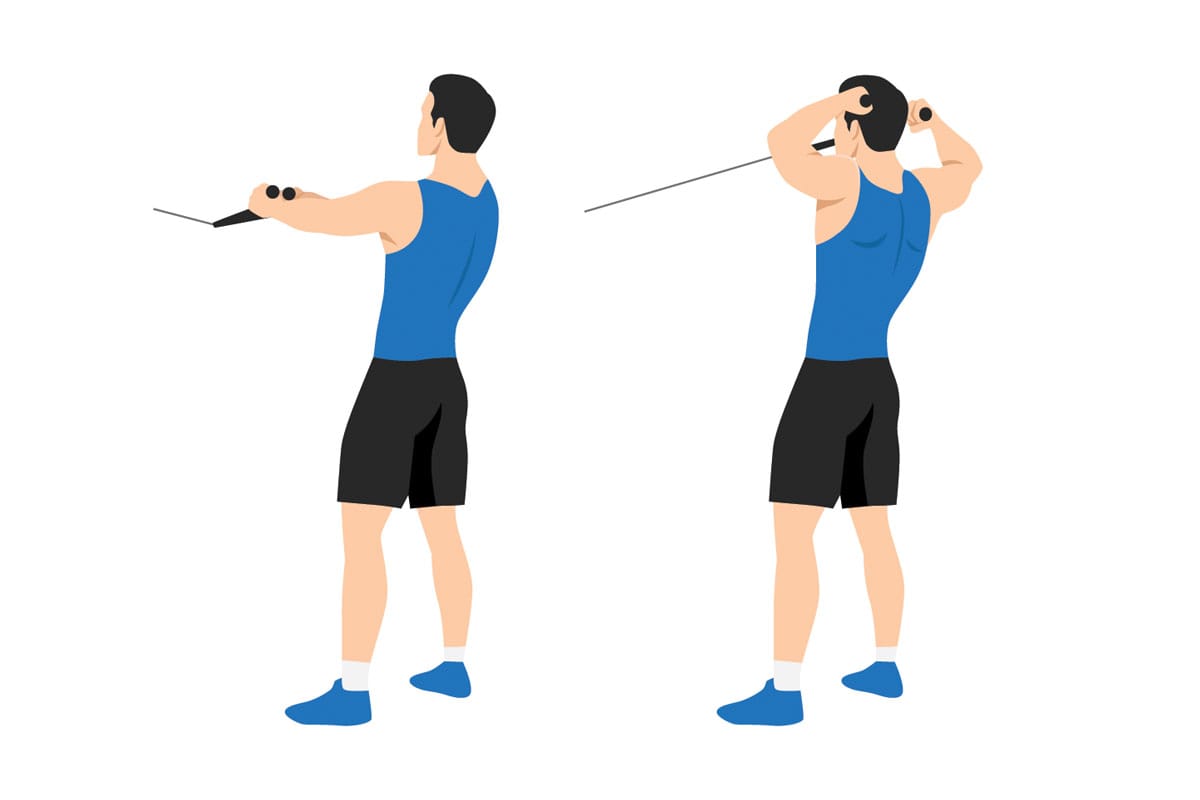Face Pull Cable Exercise: Benefits, Technique, and 3 Variations
The Face Pull Cable is one of those exercises that can make a world of difference in your shoulder health and posture. Check out the variations
If you're serious about your fitness journey, especially when it comes to building a solid upper body and maintaining healthy shoulders, you've probably heard of the Face Pull Cable exercise. But are you doing it right? Or maybe you're wondering why this exercise is even worth your time.
Well, let me tell you, the Face Pull Cable is one of those underrated exercises that can make a world of difference in your workout routine, especially for shoulder health and posture.
In this article, we’ll break down everything you need to know about the Face Pull Cable: benefits, proper technique, common mistakes, and even a few variations to spice things up. By the end, you’ll be ready to incorporate this move into your workouts like a pro.
What is the Face Pull Cable Exercise?
So, what exactly is a Face Pull Cable exercise? Basically, it’s a compound shoulder exercise where you use a cable machine (or resistance bands if you're working out at home) to strengthen the muscles in your upper back and shoulders. We’ll get into specific muscles later on in this article.

The exercise gets its name because, well, you’re literally pulling the cable toward your face. But don’t let that scare you. Done correctly, it’s a safe and incredibly effective exercise that can help you build a strong, stable upper body.
Now, why is this exercise so popular? It’s because it helps with a bunch of things that most people struggle with, especially if you spend a lot of time sitting (hello, desk job!).
Over time, sitting can lead to rounded shoulders and poor posture. The Face Pull Cable helps counteract that by strengthening the muscles that pull your shoulders back into alignment.
Muscles Worked by the Face Pull Cable
Let’s take a quick look at what muscles the face pulls work. While it’s primarily known for targeting the shoulders, it actually hits a variety of muscles in the upper body, making it a fantastic all-around exercise for shoulder health and posture.
1. Rear Deltoids (Rear Delts)
The main muscle group targeted during this exercise is the rear delts, which are located on the back of your shoulders. Strengthening the rear delts is crucial for balanced shoulder development, especially if you're doing a lot of pressing movements like bench presses or overhead presses, which tend to overwork the front delts.
2. Trapezius
The upper and middle portions of the traps are heavily engaged during the pull. These muscles are responsible for moving and stabilizing the shoulder blades. Strong traps are essential for good posture and shoulder mobility.
3. Rhomboids
Located between your shoulder blades, the rhomboids are responsible for pulling your shoulder blades together. These muscles play a big role in maintaining good posture, and they’re activated when you squeeze your shoulder blades at the top of the movement.
4. Rotator Cuff Muscles
The group of four smaller muscles that helps stabilize the shoulder joint is called the rotator cuff. These muscles don’t get as much direct attention in most workouts, but they’re crucial for shoulder health and injury prevention. The Face Pull Cable is one of the best exercises for strengthening the rotator cuff.
5. External Rotators
While not a specific muscle group, the external rotators of the shoulder are activated during the pull, especially when you focus on keeping your elbows high and pulling the rope apart. This helps improve shoulder stability and mobility, which is essential for preventing injuries.

Benefits of Face Pull Cable
Alright, now that you know what it is and which muscles are involved, let’s talk about why you should be doing it. The Face Pull Cable isn’t just another fancy shoulder cable workout to throw into your routine; it’s a must-have for anyone looking to improve shoulder health, posture, and overall upper body strength.
1. Improves Shoulder Mobility and Stability
One of the biggest benefits of the Face Pull Cable is how it improves shoulder mobility and stability. By targeting the rear delts and rotator cuff muscles, this exercise helps keep your shoulders strong and flexible, which is essential for preventing injuries. Whether you're lifting heavy weights, playing sports, or just going about your daily life, strong and mobile shoulders are key to staying injury-free.
2. Prevents Shoulder Injuries
Speaking of injuries, let’s be real: shoulder injuries are all too common, especially if you’re trying to improve on your PR and bench more. The Face Pull Cable can help you avoid this by strengthening the smaller, stabilizing muscles in your shoulders.
3. Improves Posture
If you’re like most people, you probably spend a lot of time sitting—whether it’s at a desk, in the car, or on the couch. Unfortunately, this can lead to poor posture, especially rounded shoulders. The Face Pull Cable helps correct this by strengthening the muscles that pull your shoulder blades back and down, which can help you stand taller and look more confident.
4. Builds Upper Body Strength
Last but not least, the Face Pull Cable is a great way to build upper body strength. While it’s not a “big lift” like deadlifts or RDLs, it complements those exercises by targeting the smaller muscles that often get overlooked. Plus, improving your shoulder stability can help you lift heavier weights in other exercises.

How to Perform the Face Pull Cable Exercise Correctly
Hopefully, you’re now already sold on the benefits. So let’s talk about how to do the Face Pull Cable correctly: form is everything with this exercise. If you do it wrong, you won’t get the full benefits, and worse, you could end up hurting yourself.
Here’s a step-by-step guide to help you nail the technique:
Instructions:
- Set the Cable Machine: First, set the cable machine to about upper chest height. Attach a rope handle to the cable.
- Grip the Rope: Stand facing the machine, and grab the rope with both hands using an overhand grip. Your palms should be facing each other.
- Step Back: Take a step or two back from the machine to create tension in the cable.
- Pull Towards Your Face: Now, pull the rope toward your face, leading with your elbows. Keep your hands apart as you pull, and make sure your elbows stay high.
- Squeeze at the Top: When the rope reaches your face, squeeze your shoulder blades together. This is where the real gains are made, so don’t rush it!
- Return Slowly: Slowly return to the starting position, keeping the movement controlled.
Pro Tips:
- Engage Your Core: Keep your core tight throughout the movement to avoid arching your back.
- Don’t Overload the Weight: This isn’t a max-effort lift. Use a weight that allows you to maintain good form.
- Focus on the Squeeze: The most important part of the exercise is the squeeze at the top. Really focus on contracting those upper back muscles.
Common Mistakes to Avoid:
- Using Momentum: Don’t swing the weight. This is a controlled movement, so take your time.
- Dropping Your Elbows: Your elbows should stay high throughout the movement. If they drop, you’re not hitting the right muscles.
- Neglecting the Squeeze: If you’re not squeezing your shoulder blades together at the top, you’re missing out on the full benefit of the exercise.
Variations of the Face Pull Cable Exercise
If you’re looking to mix things up, there are a few variations of the Face Pull Cable that you can try. These are great for targeting different muscles or adding a new challenge to your routine.
1. Single-Arm Face Pull
This variation allows you to focus on one side at a time, which can help correct any muscle imbalances. It’s also a bit more challenging because you have to stabilize your body with just one arm.
2. Face Pull with Bands
No cable machine? No problem! You can do the Face Pull with resistance bands. Simply anchor the band to a sturdy object and follow the same steps as you would with a cable machine.
3. Face Pull with External Rotation
For an added challenge, try adding external rotation to the movement. After you pull the rope toward your face, externally rotate your shoulders so that your hands move upward. This variation targets the rotator cuff muscles even more.
How to Incorporate Face Pulls into Your Workout Routine
So, when should you do Face Pulls? Ideally, you should include them in your routine 2-3 times per week. They’re a great addition to any upper body day, especially if you’re doing a lot of pressing movements like bench presses or overhead presses.
Rep and Set Ranges:
- For beginners, aim for 3 sets of 12-15 reps.
- If you’re more advanced, you can do 4 sets of 8-12 reps with a slightly heavier weight.
You can also use Face Pulls as a warm-up exercise to activate your shoulders before heavy lifting or as a finisher to really burn out your upper back muscles.
Final Word
The Face Pull Cable exercise is a must-have in any well-rounded workout routine. Not only does it help improve shoulder mobility and prevent injuries, but it can also correct posture and build upper body strength. Whether you’re a seasoned lifter or just getting started, this exercise deserves a spot in your routine.
So, give it a try! Focus on your form, avoid common mistakes, and start reaping the benefits of stronger, healthier shoulders. Trust me, your body will thank you.
Ready to conquer the body of a Greek god? We’ve made it simple to work on customized fitness plans or to introduce a little friendly competition to your fitness community by sharing exercises with your friends. Get started for free through the Flex fitness app.
Related articles


Get fit with Flex
Build muscle & lose weight fast for free.
Available on iPhone + Apple Watch





